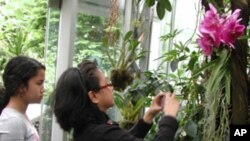A plant in Namibia survives on fog. Visitors can get a rare look at the Welwitschia or Desert Onion on display at the U.S. Botanic Garden, a glass-domed building at the foot of the United States Capitol in Washington.
Opened in 1820, the U.S. Botanic Garden houses more than 10,000 plants in exhibits which reflect the world’s deserts, jungles and other landscapes. Rare and endangered species are spotlighted.
Horticulturalist Ray Mins says the lush varieties in and around rocks of an artificial lava flow and waterfall in the Hawaii room, drive that message home.
“Hawaii has one of the smallest land masses in North America, but has the largest percentage of endangered species. Almost every plant you see in this room is endangered.”
Mins points out Brighamia or “Cabbage on a Stick” whose population has been decimated in the wild due to overgrazing, development and competition from invasive plants.
Mins says the delicate balance between plant and pollinator has been upset “The pollinator of that plant is extinct and there’s no natural way for that plant to be pollinated, although in captivity you can pollinate it.”
Jody Johnson represents Pollinator Partnership and was among two dozen exhibitors who were recently stationed at booths along garden walkways. Her group promotes the health of pollinators, critical to food and ecosystems.
She says beyond the birds, bees and butterflies are other important pollinators to watch. “Bats, geckos, and flying squirrels being examples that people don’t know about.”
Like all flowers, orchids are dependent on pollinators. The U.S. Botanic Garden has some 5,000 species which are grown and propagaged at the garden's research center.
The way they are rotated 200 at a time into tree trunks and branches along a misty forest like walkway captivates Californian Josefina Mateo, and her family, visiting from the Philippines. “I saw this little nook in the corner with orchids from the Philippines. That got me excited.”
As his sister-in-law takes pictures, Raul de los Santos gets a closer look at an orchid he rarely sees at home.
“Having this represented helps especially for my kids to understand that there are certain things to be more aware of in the environment. We’re losing a lot of the special species that we have.”
Horticulturist Mins is troubled that so many orchids, like the ones in this display, are endangered, largely from illegal collectors.
He says the orchids help teach a lesson to passersby. “We hope that people see the beauty of native and endangered plants and can walk away understanding that actions that we take as humans and as gardeners really can affect plants and what we can do at home can help protect endangered species.”
Nancy Guyer of Clinton, Maryland comes to the garden to relax and is moved by what she sees.
“When something is gone from the world, there is no getting it back. And everything on earth was put there for a reason, and it all affects how we live.”









